Retail, Hospitality and Tourism Headed Toward Recovery

While many different industries and sectors bore the brunt of the impacts of the past year’s pandemic, few were as impacted as Retail, Hospitality and Tourism (RHT). As we look forward to a post-pandemic world, what will the future of these industries look like in our region?
On April 16th, Valley Vision, in partnership with the Los Rios Community College District, and in collaboration with Sierra College, Yuba Community College District and the Capital Region workforce boards, held a Regional Advisory on Retail, Hospitality, and Tourism occupations and careers. Regional Advisories provide forums for industry and employer representatives to discuss their current and expected skill needs with educators and workforce system stakeholders. These advisories, funded by Strong Workforce Program, ensure community college and workforce training programs are responding to industry needs, preparing students and community members for the continuously evolving world of work.
The advisory began with Mike Testa, President and CEO of Visit Sacramento, providing an encouraging forecast. He discussed multiple events and campaigns scheduled to draw visitors back to our region including Farm-to-Fork Festival, Tower Bridge Dinner, Ironman Triathlon, Aftershock Music Festival, and Junior Olympics in 2022. The anticipated reopening of the Safe Credit Union Convention Center will also be a huge draw for visitors and conference attendees. Visit Sacramento looks beyond simply boosting the economy, and providing jobs as the city reopens according to Testa, “At Visit Sacramento, internally we say that tourism isn’t about the tourist – it’s about driving revenue for the residents that live here. The money that comes in improves the lives of our residents.”
Next up, Dr. Robert Eyler, President of Economic Forensics and Analytics, Inc., provided a look at the changing dynamics in these industries over the last year and projections for recovery. Examining from a macro lens, he described how the hospitality industry in California displayed the most dramatic job loss, at nearly 30% loss of employment since March of 2020. While a handful of sub-sectors within the Retail industry profited during the pandemic, including e-commerce, retailers selling building or gardening materials, and food or beverage retailers, the majority of the industry suffered job losses from 2.6% to 18.6%. Dr. Eyler remarked that while the past year for the RHT sector has been grim, Summer 2021 hints at the beginning of recovery for restaurants and retail with travel picking up in 2022 and 2023, and full recovery (pre-COVID levels) expected by 2024 or 2025.
Several regional employers participated in the panel discussion including: Tim Stallings – Sacramento Republic Football Club; Bahar Abullarade – Raley’s Supermarkets; Alycia Harshfield – California Restaurant Foundation; Bobbin Mulvaney – Mulvaney’s Building & Loan Restaurant; and Lynn Mohrfeld – California Hotel and Lodging Association. They shared the ways COVID-19 affected their businesses and delved into the types of skills and knowledge students and individuals interested in joining the RHT sector will need. The panelists unanimously agreed that emotional intelligence skills – often known as “soft skills” – were crucial indicating candidates who possess critical thinking skills, interpersonal skills, and the ability to effectively communicate are highly sought after. In the digital age of the pandemic, panelists explained that most of their workers quickly adapted to technological changes, but struggled when it came to effectively connecting with their clientele and fellow staff members. The employer panel also stressed the importance of team-building, working collaboratively, and the ability to work with diverse groups.
While the pandemic has brought with it a continuous wave of uncertainty, the promising projections from Mike Testa and Dr. Eyler, along with accounts of resiliency and adaptability from industry representatives, provided an encouraging picture of a sector headed toward recovery. Even within an increasingly technological age, this advisory has shown the way to be successful in RHT occupations and careers is to embody key parts of the industry itself – forming connections, working together, and serving your community.
To keep up with Valley Vision’s work to advance a future-ready workforce in the Sacramento region, subscribe to our 21st Century Workforce email newsletter!
Caitlin Blockus is a Valley Vision Project Associate supporting initiatives within the 21st Century Workforce impact area.
Capital Region Workforce Boards Champion Digital Inclusion

The Capital Region’s four workforce boards recognize the digital divide must be addressed in order to support inclusive job growth and social mobility for our region’s workers. In response, they have provided a significant investment in the Sacramento Coalition for Digital Inclusion’s (Coalition) efforts to address digital skills, technology access, and broadband infrastructure and affordability needs. The Capital Region Workforce Boards include SETA/Sacramento Works, Golden Sierra Job Training Agency, YoloWorks and North Central Counties Consortium. According to Roy Kim, Deputy Director of SETA/Sacramento Works, “Digital skills have become part of the basket of basic skills that job seekers need to obtain employment and advance along a career pathway.” The funding provided will support the effort to sustain, implement and expand the Coalition’s work to ensure traditionally underserved community members receive access, devices and skill building resources to participate in our increasingly digital world.
Valley Vision is actively working to close the digital divide in the Capital region. The Coalition, managed by Valley Vision, recently completed a 2021 Action Plan as a roadmap to advance and expand digital inclusion in three core areas: broadband access and adoption, hardware devices, and digital literacy and skills. Valley Vision also manages the Connected Capital Area Broadband Consortium, connecting the region’s underserved households with high speed broadband infrastructure. By addressing needs in infrastructure, affordability, technology access, and digital skills, our region is taking a comprehensive approach to closing the digital divide – recognizing that these pillars are co-equal in addressing economic and educational inequity.
The Coalition was founded as a response to the 2018 Brookings Institution economic assessment, commissioned by Valley Vision and civic partners in the Sacramento Capital Region. With the onset of COVID-19, the Coalition quickly mobilized and expanded vital digital equity efforts. The effort has expanded since that time and today consists of a steering committee of representatives from the City of Sacramento and the Sacramento Public Library, as founding SCDI members, and the Capital Region Workforce Boards, California State University Sacramento, Los Rios Community College District, and Clear Strategies with participation from over one hundred additional community leaders and stakeholders. Advancing digital skills and closing the digital divide are called out as major regional priorities in the Capital region’s inclusive economic development plan, Our Path Forward: The Prosperity Strategy.
The Workforce Boards have been vital contributors to the region’s economic prosperity with prior initiatives that support entrepreneurship, high-growth industry sectors, and through advancing research on the Future of Work. This critical investment in digital inclusion will help to advance an inclusive, regional workforce and further equity efforts in our shared economy.
To keep up with Valley Vision’s work to advance a future-ready workforce in the Sacramento region, subscribe to our 21st Century Workforce email newsletter!
Renee John is a Valley Vision Project Leader managing initiatives within the 21st Century Workforce impact area.
Note: The Connected Capital Area Broadband Consortium is funded by the California Public Utilities Commission (CPUC).
Building Resilient Skills in the Face of Uncertainty

“Think about it: The pace of change has never been this fast, yet it will never be this slow again.” Justin Trudeau made this statement at the World Economic Forum in Davos in January 2018. In Valley Vision’s 21st Century Workforce impact area, we are seeing the truth of this statement over and over again. The joint pressures of coming out of one of the largest dislocations of workers in our history, the accelerated adoption of automation, and the necessity of determining a recovery strategy inclusive of our region’s diverse workforce combine to require a novel, aligned strategy to prepare our entire population for the Future of Work.
Valley Vision has been working on Future of Work strategies for several years. With funding from the Capital Region’s four workforce boards; Sacramento Employment and Training Agency, Golden Sierra Job Training Agency, North Central Counties Consortium and YoloWorks, Valley Vision has conducted research to anticipate the skills and knowledge needed for the workplace of tomorrow to ensure a ready, regional workforce including producing Automation Risk for Jobs in the Capital Region report. Through funding from the Los Rios Community College District, Valley Vision has convened advisories in specific industry and occupational sectors to identify emerging trends and ensure a workforce that meets employers’ evolving needs.
Recently, through an award from the City of Sacramento CARES funds, Valley Vision was able to embark on a research partnership with Burning Glass Technologies to analyze job posting data to identify transferable, destination occupations for community members laid off from COVID-19. This work builds off the Automation Risk for Jobs in the Capital Region report which looked at the proportion of high risk jobs within the nine county capital region and the demographics breakdown within those jobs.
As the COVID-19 pandemic hit, we saw the jobs identified at highest risk of automation experience the highest layoffs. The correlation of dislocated workers to high automation risk occupations points to the uncertainty of how many original jobs will return and the increasing need to prepare our region’s workforce for more resilient careers, able to withstand advances in automation and other market disruptions. This new research from Burning Glass Technologies identifies the specific skills needed to move job seekers from high risk positions to more stable occupations at similar or higher wages.
This information will be highlighted in a joint webinar with the City of Sacramento as we review the initial research findings. Additional information will be forthcoming, identifying the highest in demand skills for employers in our region. We invite you to stay connected to Valley Vision as we explore the Future of Work together and create pathways for all community members to benefit from our region’s shared prosperity.
To keep up with Valley Vision’s work to advance a future-ready workforce in the Sacramento region, subscribe to our 21st Century Workforce email newsletter!”
Renee John is a Valley Vision Project Leader managing initiatives within the 21st Century Workforce impact area.
The First 90 Days

As of this week, I’ve been in the position of CEO of Valley Vision for 90 days – which is often counted as a milestone for a new job. During these 90 days I’ve focused on learning the job; engaging with community partners, stakeholders, Board, and staff; and developing a set of priorities for Valley Vision into 2021. What is my vision for Valley Vision?
1. Deepening Our Commitment to Social and Racial Equity
My career focus has always been on strengthening equity in communities – from early in my career working on gender equity to the many projects I’ve advanced at Valley Vision that create equitable opportunities. As CEO, it is important to me that Valley Vision’s commitment to social and racial equity be authentic and apparent through our actions. In July, the Valley Vision staff team participated in a Whiteness at Work web series to examine how dominant white culture and anti-Black culture impacts our staff, teams, and work in and for the community. We ended the series with new resources, a new staff-led Equity Subcommittee, and an identified set of actions to cultivate inclusion and equity within our staff and through our work. We are starting with ourselves – building trust, team cohesion, and a common set of values that are foundational to our work. Our goal is to develop our own framework to advance operationalizing equity in our organization and throughout our work.
2. Visionary Planning and Investment Strategies
Valley Vision’s role in the region is to set our eyes on long-term solutions to create economic prosperity, social equity, and environmental sustainability in the region. To do this, Valley Vision is known for advancing research, fostering collaboration, and catalyzing action. We also need an engine to achieve needed investment to solve our region’s larger challenges. Therefore, Valley Vision is engaging in more intentional investment planning including working with community leaders and partners to create comprehensive, co-designed strategies which will create project and investment-ready coalitions to advance bold solutions. We have an opportunity to meet our region’s greatest challenges together through ambitious, co-owned solutions that will position our region as one of the most livable in the nation.
Our first focus is on developing an investment strategy to advance digital inclusion in the region by expanding broadband infrastructure and connectivity, supporting access to needed technology for all, and advancing digital skills for the workforce. We are already co-leading the Sacramento Coalition for Digital Inclusion with other partners to create the systems, tools, and skills needed for all to fully participate in civic life, education, and work. Reaching our long-term solution to truly create digital equity in the region will require a big-umbrella vision to inspire investment — because if we don’t know where we are going, how will we get there?
3. Creating Actionable Research and Sharing Our Insights
Our region and communities are transforming more rapidly than in generations. Between coronavirus, effects of climate change, upcoming elections, the pace of technology change and adaptation, and more – life has never been so complex. That is why it is more essential than ever to have the data and information needed to adapt, recover, and reimagine our future. There are a few main areas where we will grow our research capacity by focusing on actionable research and advancing a commitment to sharing best practices.
- Actionable Research: We believe that decisions should be informed with data and we are expanding our capacity to create actionable research. We have already built two new partnerships in the last six months to be able to do just that – Capital Public Radio for our polling initiative and Burning Glass Technologies to analyze rapidly changing workforce needs. We’ve also hired Dr. David Espinoza to manage the Connected Capital Broadband Consortium – bringing his GIS and other analytical expertise to our team.
- Sharing Lessons Learned: Valley Vision’s ability to collect and analyze unique data for the region is one of our key strengths. We generate a tremendous amount of data and lessons learned at Valley Vision, but it has not always been our regular practice to slow down in order to share the unique data and the stories from the field that we have collected. I’m very committed to reporting out regularly as well as connecting with other publications and networks to share our work, insights, and recommendations.
The Valley Vision I envision is an inclusive organization with clear values around equity; is action-oriented, collaborative, and poised to do big things; and is always pushing forward to find new information, connect the dots, and support data-driven decision-making in our region. Let’s get to work.
To keep up with Valley Vision’s work to advance livability in the Sacramento region, subscribe to our Vantage Point email newsletter!
Evan Schmidt is Valley Vision’s Chief Executive Officer.
Highlighting Sacramento Region Digital Inclusion Efforts
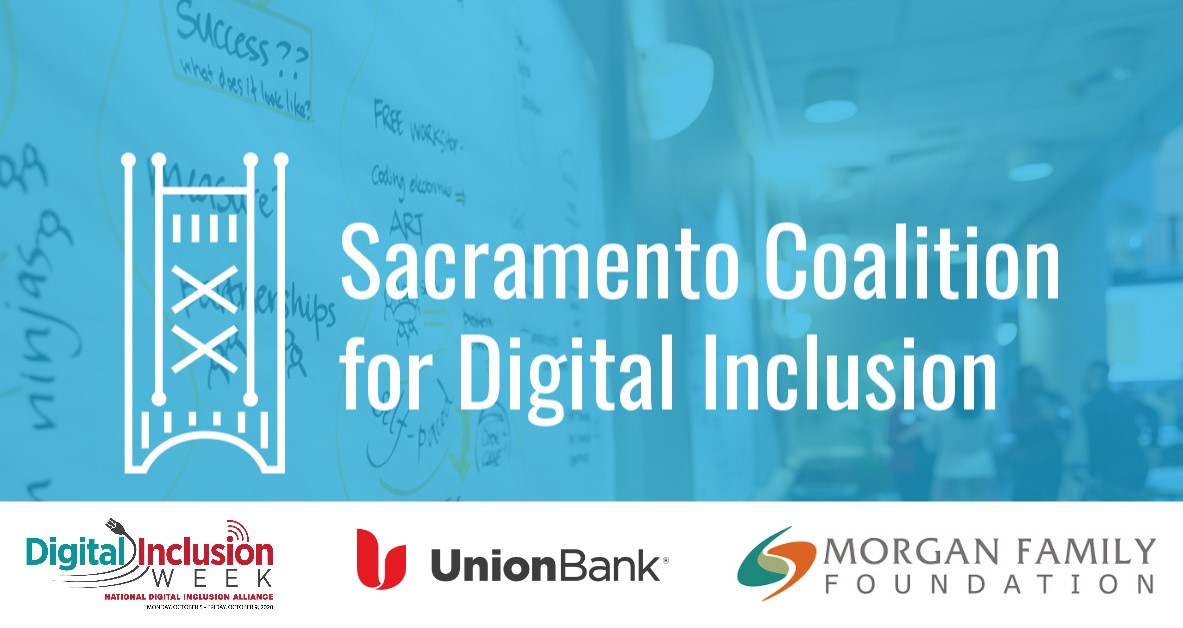
There has never been a more critical time for discussion of digital inclusion which has recently been referred to by the Center for Public Integrity as the “civil rights issue of our time.” As the Pandemic has upended education and workforce, it has left in its wake a widening chasm between community members with resources and those without. In recognition of National Digital Inclusion week, Valley Vision highlights the history, continuing collaborative work, and new momentum of the Sacramento Coalition for Digital Inclusion, a regional approach to creating more opportunities for digital equity.
Discussion which formed the beginnings of the Sacramento Coalition for Digital Inclusion began in the fall of 2018 inspired by a Brookings Institution report on the strengths and weaknesses of the Sacramento Capital region. A series of community discussions occurred to organize around the mission of digital equity, with the Sacramento Public Library hosting the Sacramento Digital Inclusion Summit in January 2019. This led to the creation of the Sacramento Coalition for Digital Inclusion, with more than 40 members, led by a Steering Committee comprised of the City of Sacramento, the Sacramento Public Library, Valley Vision and Social Ventures Partners. During 2019, the Coalition built collaborative relationships, conducted assessments of needs including through community engagement, and produced an initial report focused on increasing digital access, both to affordable Internet and devices, and digital literacy/skills. The City of Sacramento passed a resolution in October 2019 to launch National Digital Inclusion Week in the region.
With the onset of the Pandemic, the work of the Coalition became even more important and the need for a funding mechanism to drive forward momentum and staff this increasingly important body of work required an urgent solution. Valley Vision has been successful in securing short term funding to continue and expand this valuable work through the Morgan Family Foundation and Union Bank, on behalf of community partners and stakeholders.
Current Coalition Steering Committee members include the City of Sacramento, the Sacramento Public Library, and Valley Vision, joined by representatives from Los Rios Community College District and California State University Sacramento, with the Coalition being a vibrant group of over 60 community members and leaders. Three working groups were successfully relaunched in a well attended September Coalition meeting to establish key objectives and drive the work plan of the Coalition in the areas of Internet Access and Adoption, Technology Devices, and Digital Literacy/Digital Skills.
Valley Vision is thankful to the dedicated efforts of the Steering Committee and all members committing their time and talent to align and drive investment in a regional and sustained response to urgent digital inclusion needs. We invite you to join in this work at our next Coalition meeting on October 23rd 11 am to 12:30 pm and help us build a regional digital inclusion work plan to address disparities throughout our region and build a better future for all.
Sacramento Coalition for Digital Inclusion Steering Committee:
- Aubrey Taylor, City of Sacramento
- Jarrid Keller, Sacramento Public Library
- Karina Talamantes, City of Sacramento, Sacramento County Board of Education
- Kevin Flash, Sacramento City College
- Tamara Armstrong, Los Rios Community College District
- Dr. Yvonne Harris, California State University Sacramento
- Trish Kelly, Valley Vision, Managing Director
- Renee John, Valley Vision
- Dr. David Espinoza, Valley Vision
- Jesse Flores, Valley Vision
To keep up with Valley Vision’s work to advance a future-ready workforce in the Sacramento region, subscribe to our 21st Century Workforce email newsletter!”
Renee John is a Valley Vision Project Leader managing initiatives within the 21st Century Workforce impact area.
Capital Region’s Workforce Boards Provide COVID-19 Relief

The COVID‐19 pandemic has created a significant disruption to the labor force, wreaking havoc on both businesses and community members. The Capital Region’s Workforce Boards are specifically positioned to provide much‐needed assistance in times like these. Our collective goal is to support the overall economic health of the region by matching employer needs for local talent with resident needs for gainful employment and career mobility. During this current crisis and ongoing, we ensure workers are job ready and preparing for the future of work to help our communities recover and thrive.
Our local, federally‐funded workforce system has been providing services to both job seekers and employers for decades, and remains one of the best assets in the Capital Region. The four Workforce Development Boards ‐ the Sacramento Employment and Training Agency (SETA)/Sacramento Works, Golden Sierra Job Training Agency, Yolo County Workforce Development Board, and North Central Counties Consortium (NCCC), cover a nine‐county region and oversee a network of over 20 America’s Job Centers that connects over 68,000 job seekers annually with much needed employment and related resources.
These business‐led boards are a resource to local employers, providing assistance with job postings, customized recruitment events, applicant screening services, skills assessments, (virtual) career fairs, and resources that promote business success. Businesses also benefit by increasing the breadth and diversity of their talent pool. Job retention is improved by candidates receiving access to ongoing job coaching and supports that improve their success in the workplace. Additionally, job seekers and the underemployed receive access to demand‐driven, relevant skills training to regain employment in a growing field and improve their earnings potential.
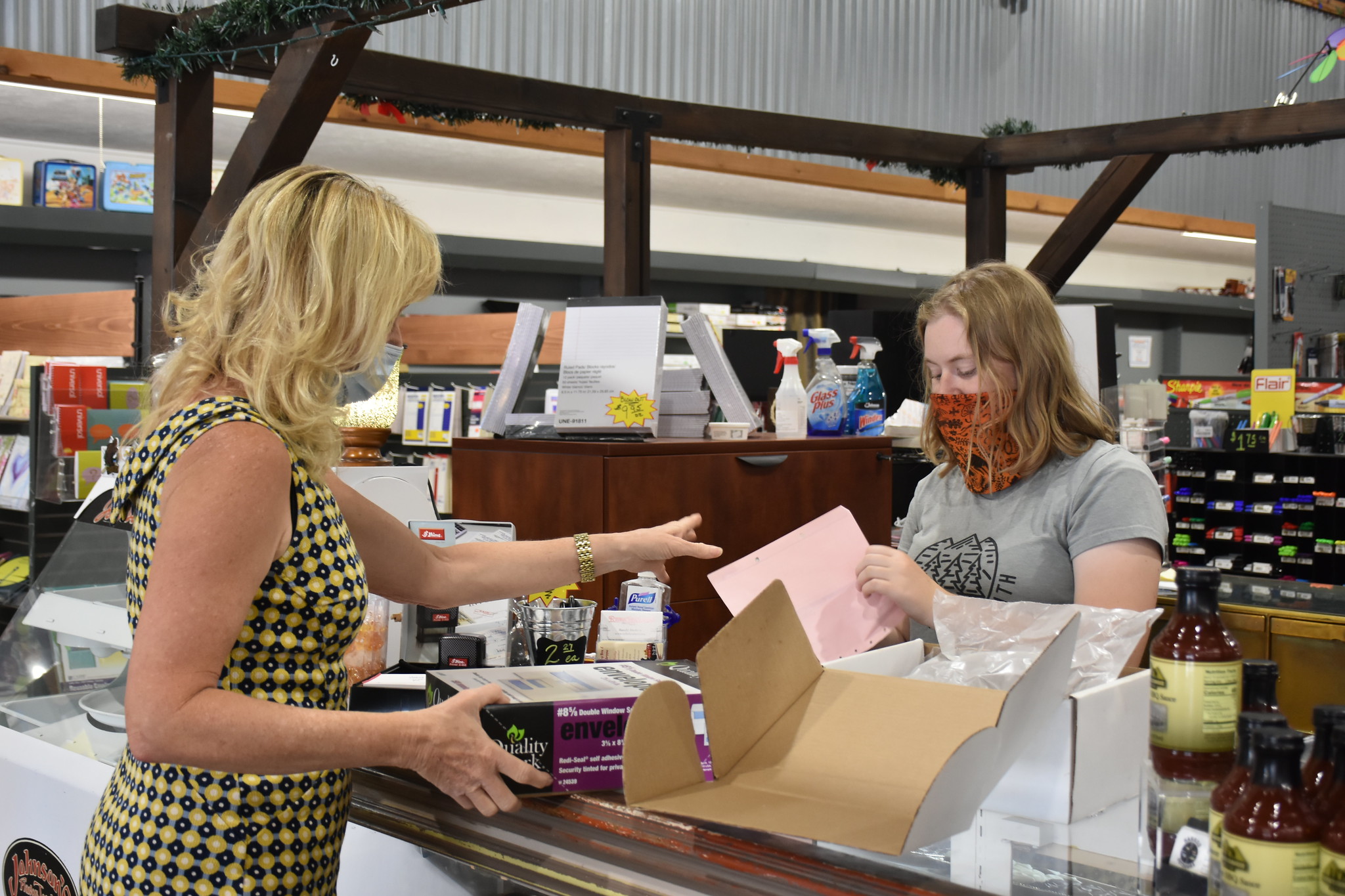
The Centers are typically located in neighborhoods and areas with high concentrations of poverty and unemployment. The Centers offer no cost workforce development resources to everyone, with a focus on individuals with significant barriers to employment, such as basic skills deficient, disadvantaged youth, public assistance, homeless, ex‐offenders, etc. and the underemployed. Over 86% of individuals receiving services have significant barriers to employment, and a majority come from underrepresented minority groups.
The Capital Region’s Workforce Boards are committed to the region’s success as conveners, brokers, leaders and partners on many workforce development initiatives that strengthen our local economy. We partner with business, education, labor unions, economic development and community based organizations to align efforts, deepen impact, and improve quality of life in our region. To learn more about the Capital Region’s Workforce Boards, please go to:
- sacramentoworks.org
- goldensierra.com
- yoloworks.org
- northcentralcounties.com
- valleyvision.org
- capitalregionworkforceboards.com
Rick Wylie, President, Villara Corporation Chair, Sacramento Works, Inc., Board
Rick Larkey, Technical Director, North State Building Industry Foundation Chair, Golden Sierra Workforce Board
Kenneth Garrett, CEO, All Phase Security, Inc. Chair, Yolo Workforce Innovation Board
John Fleming, Director of Planning & Development, Ampla Health Chair, North Central Counties Workforce Board
Innovative Partnership Will Build a Roadmap to a Resilient Workforce
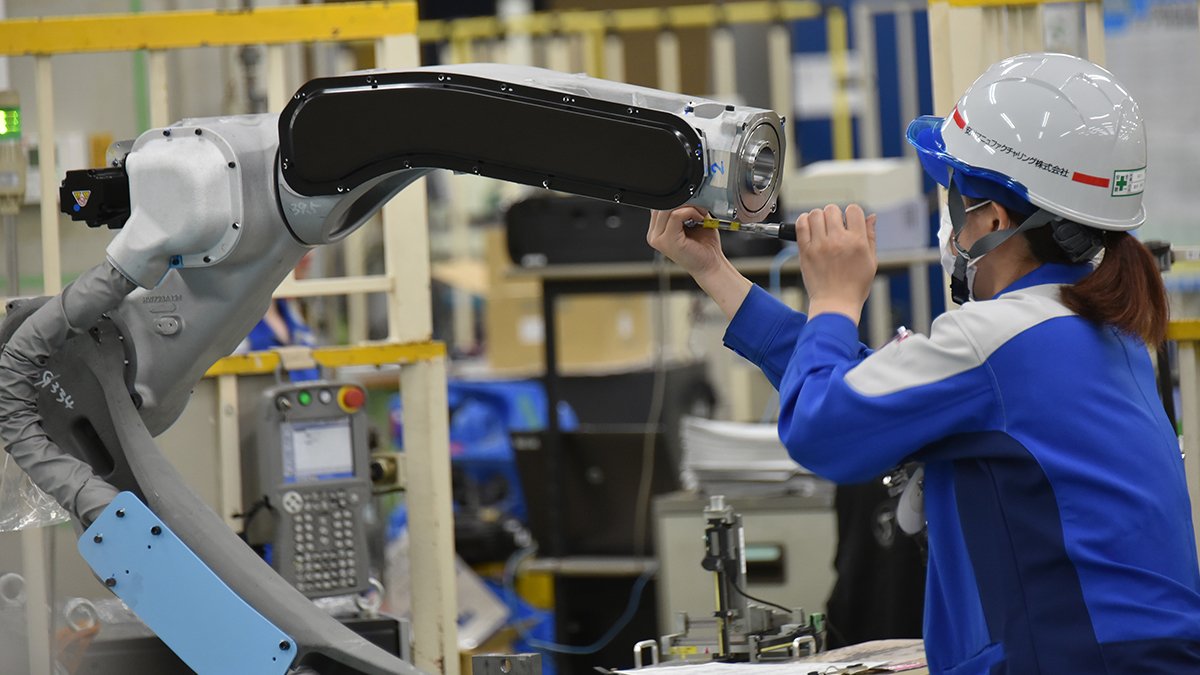
Thanks to funding committed by the City of Sacramento CARES Act program, Valley Vision is excited to announce a new partnership with Burning Glass Technologies to support upskilling, digital skills, and re-employment in the City of Sacramento, targeted at those impacted by COVID-19.
Even before COVID-19 struck, we knew a third of the jobs in the Sacramento region were at high risk of automation and digital skills are key to social mobility. COVID-19 is accelerating those trends and increasing the pace and intensity of economic disparities – especially for vulnerable populations, including people of color and women. A key challenge has been to create an actionable roadmap to understand where the opportunities are to move low wage/high risk jobs to more resilient, higher wage jobs that create social mobility. Additionally, while we understand digital skills are needed, we don’t have a clear or comprehensive enough picture of what digital skills are needed for high growth jobs and where people can go to gain those skills.
Together, Valley Vision and Burning Glass Technologies will create actionable research assets to connect these dots. The three key focus points for our rapid response research assets include: (1) a report that translates high risk/high unemployment occupations with skills-adjacent occupations that are lower-risk, stable, or growing in demand; (2) an identification of current and emerging digital skills needs by industry and target occupations to inform short-term training and reskilling opportunities for rapid re-employment; and (3) implementation strategies to inform re-employment and reskilling strategies to address job loss, especially for those in underinvested neighborhoods and those most intensely impacted by COVID-19.
Matt Siegelman, CEO of Burning Glass Technologies is also excited about the research investment and the partnership, “To ensure that workers in the Sacramento region can position themselves for the high mobility opportunities that are on the way, it’s crucial to have an accurate assessment of how automation will impact work and what new digital skills will be in demand. We are excited to partner with Valley Vision in developing a clear and actionable basis for empowering the workforce of this highly dynamic region.”
Burning Glass Technologies, located in Boston, is an analytics software company powered by the world’s largest and most sophisticated database of labor market data and talent. It tracks 3.4 million job listings daily, across more than 50,000 job boards and corporate sites – using the power of big data to capture market activity with enough specificity to enable companies to take a data-driven approach to workforce planning, and enable education and governments to better align their programs with the job market. Burning Glass was recently touted in Forbes as one of the “preeminent data analytics firms worldwide in the employment field.”
The Capital region needs to move rapidly to address the twin workforce challenges: the unfolding crisis of COVID-19, and the accelerating pace of technology disruption and skill automation. The new partnership with Burning Glass deepens Valley Vision’s work in this vital impact area and will position the City of Sacramento, employers, educational institutions, and workforce systems to rapidly and accurately respond to these dual challenges.
To keep up with Valley Vision’s work to advance a future-ready workforce in the Sacramento region, subscribe to our 21st Century Workforce email newsletter!”
Evan Schmidt is Valley Vision’s Chief Executive Officer.
New Beginnings

I’m very excited to be writing to you today as Valley Vision’s new CEO. After six years at Valley Vision, most recently as the Director of Research and Strategy, I’m well acquainted with and fully committed to Valley Vision’s triple bottom line values of economic prosperity, social equity, and environmental sustainability to create livable communities. I’m also very aware that I’m coming into this leadership position at a difficult time in our history. As I begin my tenure as CEO, here is what I believe Valley Vision will need to focus on for the next three months and beyond, as we continue to navigate turmoil and challenges to our communities, economy, and well-being.
- Work from our strengths to be of service: Valley Vision is a servant leadership organization – we act as a regional steward to be of service to the people and places of our region. We are at our best when we are driving and catalyzing collaboration, advancing cutting edge applied research, and inspiring communities and leadership. With this in mind, we’ve prioritized a specific set of collaborative work to address challenges of the moment: creating an inclusive economy to support the region, creating pathways to future jobs, advancing digital inclusion for all, and increasing broadband access. The problems we face are complex and broad – Valley Vision will do best to focus our actions where we can be effective and valuable using our strengths to solve pressing issues.
- Do the next right thing: In this time of deep uncertainty, we act from our values and integrity and put one foot in front of the other to do the next right thing, even when it is hard or the big picture is unclear. In early Spring, that meant retreating to our homes to work and aiding in emergency response as we could. This summer, that has meant reflecting on how we can more deeply focus on racial justice, including participating in in-depth racial equity training during the month of July and developing concrete plans for ensuring that racial equity is central to our mission and apparent in the ways we recruit and empower diverse staff and the ways we advance our work. In the face of shifting conditions and difficulty, it is important to keep moving forward and meet each new challenge with compassion and humanity.
- Take the opportunity to reimagine: Change is knocking on our door, are we going to listen? COVID-19 has illuminated weaknesses in our systems. Let’s not rush to restore as we move forward in recovery – rather, let’s reimagine a better, more equitable future that reflects the world we need now, not the legacy of the past. The pain that has brought about a more widespread awareness of social injustice can pave the way for needed systemic changes to create a more just society. The pivot towards remote education can pave the way to more accessible and tailored educational systems that meet the needs of more students. The sudden grounding to home can create a path to more telework opportunities in the long term, reducing pollution and climate change impacts. These opportunities to change are here, it is up to us to seize them.
The job ahead won’t be easy and the conditions are as complex and difficult as I’ve seen in my lifetime. Since the announcement of my new position as CEO, I have been grateful for the expressions of support of many leaders and community members in our region. I know that I will continue to rely on that support, just as people in this region can rely on me. Grappling with the challenges that we face in the region will require that we do this together, working to reimagine and create a future that is better than our past.
Evan Schmidt is Valley Vision’s Chief Executive Officer.
The Valley Vision Way
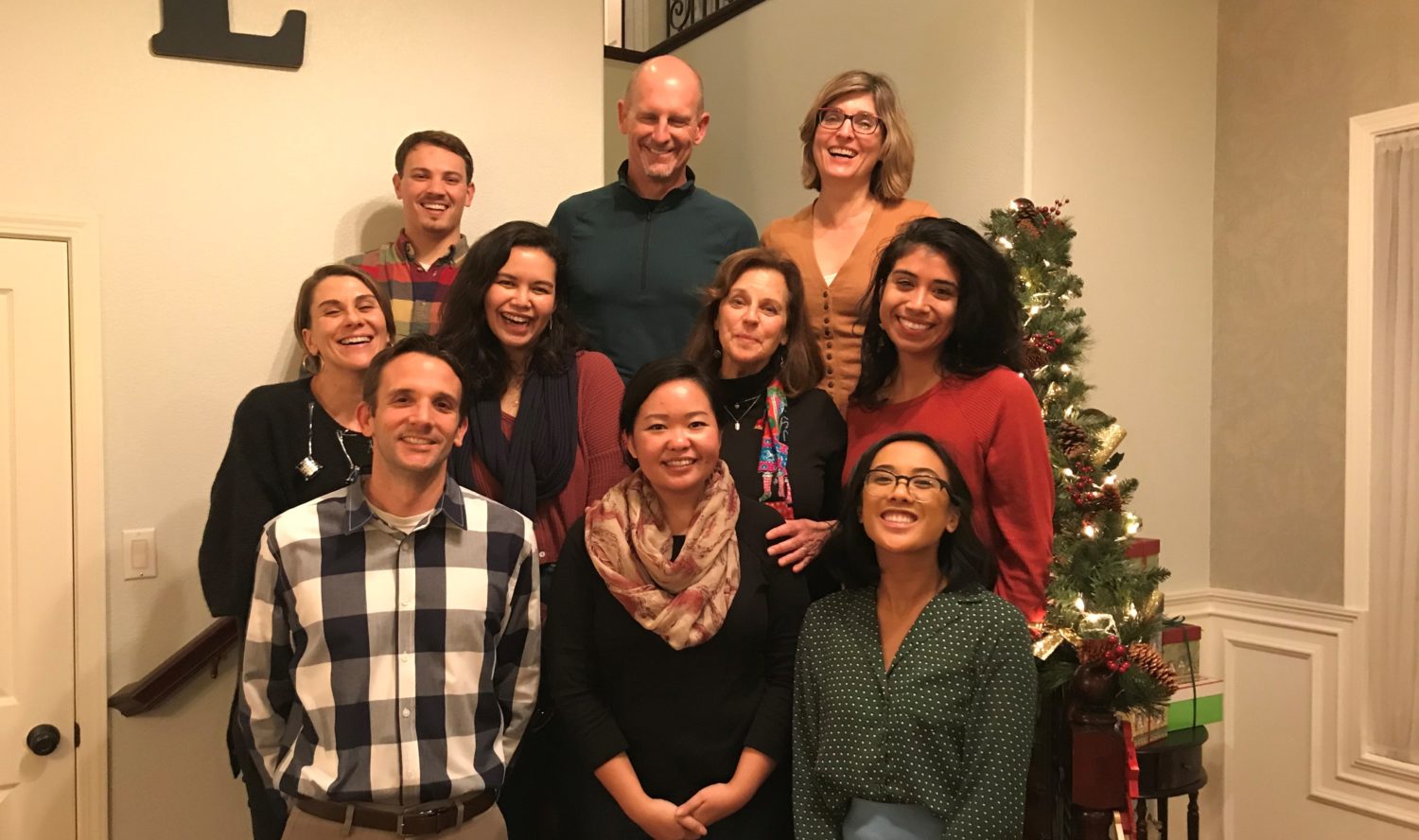
As I bid farewell, I finally understand the meaning of “the Valley Vision way.”
During my early days with Valley Vision, I heard the team refer to a number of matters as “the Valley Vision way.” For a few months I found myself trying to navigate the meaning of that phrase. I would analyze the context of when and how it was used as I was ultimately trying to box it into a compact, traditional definition. I would ask myself: “What is the Valley Vision way?”
It didn’t take long to realize that therein laid my dilemma: I was attempting to apply a single definition to an organization that is anything but compact or traditional. Valley Vision is dynamic, ever-changing and evolving, abstract and complex, in the work it conducts for the region.
That being said, and in accordance with the unpredictable nature of the work on any given day, one might find a VV’er closing the region’s digital divide by producing research, and coordinating partnerships that directly influence policy to improve equity through broadband access for all.
Or, another VV’er who is diligently involved in improving health outcomes from the impacts of climate change and emission reductions.
Simultaneously, a team of VV’ers might be launching a statewide campaign to boost emergency preparedness for California’s most vulnerable populations when disaster hits.
All of this could be happening, while in the background a ping-pong match with an undefeated champion goes down. On the best days one of our furry friends is in the office. However, it isn’t long until the work resumes. Research continues. Policy work advances. Convenings move forward.
Ultimately, the Valley Vision team became my friends, and in some ways a remote extension of a family that I hoped for upon returning to the region two years ago. To say I’ve had a good time would be an understatement, because it was the people that made the difference every day.
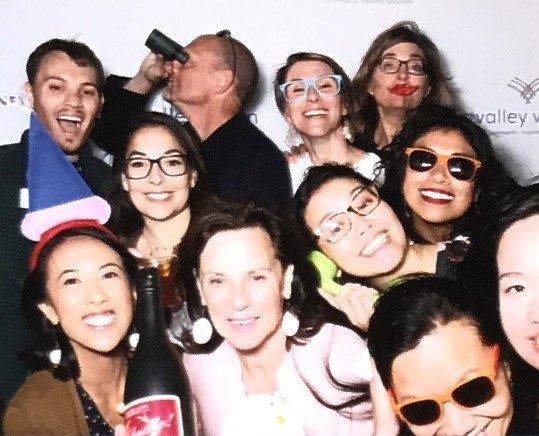
I always found comfort, and humor in the company of my podmates. Yzabelle’s compassion for the people, pets, and plants around her was a calming strength I drew from daily. Houa’s mutual appreciation for shows like The Office ensured my jokes didn’t fall on deaf ears – but when they did, we could always rely on a laugh from our King of dad jokes, Adrian, or our Queen of puns, Isa. On countless occasions, I left many conversations humbled by pearls of wisdom, advice, and more contextual knowledge than I bargained for. If wisdom really was made of pearls, Trish would dominate the Oyster industry! The point is, I am so appreciative of my experience with Valley Vision over the past year and a half. I have acquired a wealth of knowledge, laughs, and memories from each team member; a team I am grateful to call friends.
It isn’t so much the adaptability and ability to pivot that defines “the Valley Vision way,” but rather it is the people – the team.
They are “the Valley Vision way,” and I am proud to have been part of the family.
Sonia Dueñas was a Valley Vision Project Associate supporting the 21st Century Workforce and Healthy Communities impact areas.
A Pathway to the Future of Work

Valley Vision and the Los Rios Center of Excellence recently released Automation Risk for Jobs in the Capital Region, a new research report on the impact of job automation in the nine-county Capital region. This report, supported by the four Capital region Workforce Development Boards, outlines the ways that automation could impact skills, sectors, and people. Additionally, Valley Vision held a webinar on May 15th to share the findings and bring together employers and experts to learn more about how automation is impacting companies here in the region. Ebony Benzing, Research Manager of Los Rios Center of Excellence, reported the key findings of the report:
- Of the 1.2 million jobs in the region, 32% are at high risk of automation, 29% at medium risk of automation, and 39% are at low risk of automation.
- Industries most at-risk of automation in the region are retail trade, accommodations and food services, and construction.
- Of the 50 occupations that employ the most workers in the region, 13 occupations are most at risk of automation, including office clerks, administrative assistants, retail salespersons, accountants, and restaurant cooks.
- The occupations most at risk employ nearly 19.5% of all workers in the region, and pay, on average $12.36 per hour.
- Differing from other regions and the nation as a whole, women in the Capital region are at a higher risk of being impacted by automation due to their higher density in high automation risk occupations, including office administration, retail, and food service.
- Of all ethnic and racial groups, historically minoritized workers are most at-risk of being impacted by automation due to the disproportionate concentration of these workers in high and medium automation risk occupations.
What has been the experience of our webinar panelists with automation and COVID-19?
- The hospitality and tourism sector has been significantly impacted by COVID-19 and, compared to other sectors in the region, is at the highest risk of automation of jobs and skills. Mike Testa, President and CEO of Visit Sacramento, noted that the global pandemic has created significant challenges for the industry, and that new ways of doing business have emerged and may remain with us. One example that he shared was that, as work goes mobile and jobs are impacted, some functions might become less relevant, like administrative support and others, much like the data reflects.
- David Banuelos Jr., Partnership Coordinator (CA Region 1), U.S. Census Bureau, noted that now is the time to find opportunities for retraining. He is seeing a disproportionate impact in layoffs to low income and minority populations and notes that it will be critically important to address the needs of these populations with support and retraining opportunities.
- While the research suggests that manufacturing sector is at high risk of automation, Kevin McGrew, Director of Quality Management at Siemens and President of the Sacramento Valley Manufacturing Initiative, indicated manufacturing is not experiencing the severity of layoffs in this region that other sectors are seeing. Rather, manufacturing has been more impacted by repurposing operations to support production of Personal Protective Equipment (PPE).

What meaning can we make of the report findings?
Automation and other technology trends already in motion will only gain momentum as the global pandemic reshapes our economy and ways of doing work. Most people are experiencing significant changes to their traditional methods of work, layoffs are rampant, and many face an uncertain future. California has received 4.5 million unemployment insurance claims and anticipates an unemployment rate greater than 20% by the end of May. As these economic impacts settle in and we build towards recovery in the future, technology trends show we might not ever return to “normal” as we knew it just a few months ago. Those in low wage, high automation risk jobs are now and will remain most vulnerable to changes in our economy and the way work is done.
How do we address these challenge?
It is critically important that we work on building system resiliency in our workforce, education, and employment systems now and take concrete steps to provide appropriate training and skill-building opportunities. Valley Vision is working to advance digital skill building and digital literacy as a critical equity strategy to promote social mobility and future job readiness. Valley Vision has championed digital skill building as a regional strategy through the Prosperity Strategy work, and has led multiple digital skill projects for the last several years. We helped establish the Sacramento Coalition for Digital Inclusion, and with support from Union Bank, are focusing on Code, Digital Media Creation and Digital Literacy for 7,500 students in high-need communities where census tracts indicate broadband adoption is less than 82% in Sacramento (California’s state-wide adoption average). We are also creating broadband access during this critical time. As the manager of the Connected Capital Area Broadband Consortium (CCABC), Valley Vision coordinates efforts to fill critical broadband infrastructure gaps and improve access in homes, schools, and businesses. This work places us at the center of strategic efforts to improve broadband access in California’s Capital Region, paving the way for future-ready infrastructure and regional prosperity. These projects are critical to closing digital skills gaps and are a key piece of the Sacramento Region’s Future of Work strategy.
As a region in the midst of rapid economic and social transformation, the challenges ahead include risks and opportunities. We need to remain encouraged, focused on navigating the needs of today while anticipating changes to come, and maintain a sense of optimism that we can create a bright, inclusive future for all. Stay tuned as Valley Vision continues advancing solutions, preparing us for a resilient and prosperous future.
Evan Schmidt is Valley Vision’s Senior Director working on the Public Opinion Surveying initiative and projects in the Healthy Communities and 21st Century Workforce impact areas.
Accelerating Our Move Toward Universal Broadband Access

On April 23, Commissioner Martha Guzman Aceves and staff from the California Public Utilities Commission (CPUC) held a public workshop to review California Advanced Services Fund (CASF) initiatives and resources, and facilitate collaboration among regional consortia, stakeholders, local governments, and broadband providers.
Commissioner Guzman Aceves began the virtual workshop with CPUC updates on COVID-19 response actions such as enforcing new Utility Consumer Protections and updating the California Teleconnect Fund to enable distance learning for rural school districts. As COVID-19 continues to amplify and exacerbate the disparities of the Digital Divide, the CPUC and other state entities are mobilizing to ensure all Californians have access to reliable and affordable Internet access and equipment.
The pandemic also highlighted the importance of broadband deployment efforts such as the CASF Infrastructure Grant Aaccount which focuses on providing broadband access to 98% of households in each consortia region, through infrastructure projects. To be eligible, projects must provide broadband service at or above 10 Mbps download / 1 Mbps upload speeds to households identified as unserved. CPUC staff highlighted high density unserved areas in each consortia region that are eligible for funding, utilizing the California Interactive Broadband Map – a tool that provides transparent information on broadband adoption, deployment, and access data. The workshop provided timely information and opportunities for the May 4th CASF infrastructure grant application deadline.
Additionally, the workshop provided opportunities for each consortium to give updates on the varying broadband projects and initiates throughout several regions of the state. Valley Vision Managing Director, Trish Kelly, facilitated this discussion. CPUC staff also provided updates on efforts to ensure that California is able to receive new federal funding programs for broadband to address critical rural connectivity gaps. This is a high priority for the Capital Region which has been locked out of federal broadband funding investments. You can access the regional consortia update PowerPoints and all of the workshop materials here.
Yzabelle Dela Cruz is a Valley Vision Project Associate contributing to the Innovation & Infrastructure and 21st Century Workforce impact areas.
Valley Vision Named Regional Organizer of Workforce Initiatives

Funded by the California Workforce Development Board through Sacramento Employment and Training Agency (SETA), Valley Vision has been working in conjunction with four workforce boards covering nine county regions to align opportunities to advance economic prosperity for the Capital Region. Recently, Valley Vision was named the official Regional Organizer to continue this effort with expanded emphasis on converging and coordinating multiple regional workforce-related projects into a more comprehensive and inclusive workforce development initiative.
Key components of this strategy include:
Continuing to Drive Demand Driven Skills Attainment
Valley Vision has been convening industry sector partners including business, education and workforce development to ensure training programs are producing skills attainment in line with employers’ evolving needs. Valley Vision will continue this work on a regional level in the following growing sectors; Manufacturing, Healthcare, Food and Agriculture, Construction, Clean Energy, Information and Communications Technology and Hospitality.
Upward Mobility
Valley Vision will be assisting the four workforce boards on creating an inclusive workforce strategy providing opportunity for economic advancement for all. This will be accomplished by ensuring new and emerging programs and initiatives serve key populations including low income, historically disadvantaged, disconnected youth, justice involved, English language learners, individuals with disabilities, homeless and dislocated workers.
Alignment and Integration
Valley Vision will continue to work across regions, institutional and process silos to further align and integrate workforce development services to create system efficiency and maximum benefit job seekers and employers alike.
Renee John is a Valley Vision Project Leader managing projects within the 21st Century Workforce impact area.